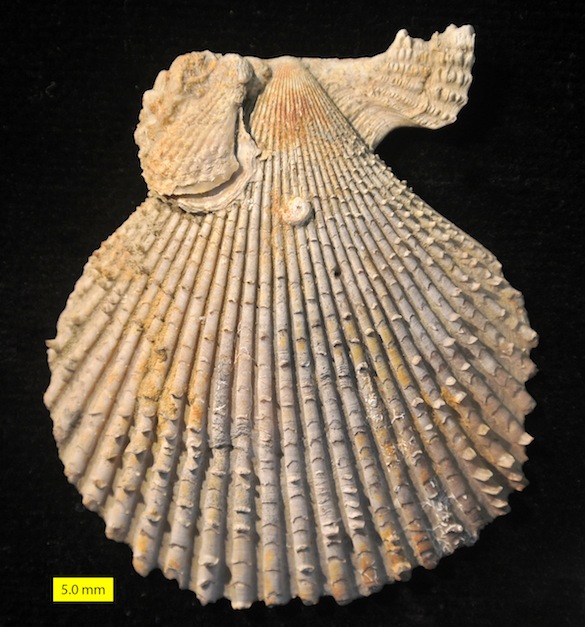 One of the very best paleontological sites I had the pleasure of collecting was on the hot Mesaoria Plain near the center of the island of Cyprus. It was the summer of 1996 and Steve Dornbos (’97) and I were pursuing research as part of a Keck Geology Consortium project. We were exploring the Nicosia Formation, a Pliocene series of thick marls with occasional fossiliferous beds. We stumbled across a remarkable fossil coral reef preserved in a hillside. This deposit and its fossils became the basis of Steve’s Independent Study project and a paper (Dornbos and Wilson, 1999). One of the most prominent (and beautiful) fossil types we found was the pectinid clam Chlamys. The specimen above fell into our category of “Chlamys sp. 1″ because we couldn’t further identify it. Note that it has near the hinge on the left a juvenile Chlamys attached to it, as well as a circular serpulid tube near the top center. The details of the shell are very well preserved.
One of the very best paleontological sites I had the pleasure of collecting was on the hot Mesaoria Plain near the center of the island of Cyprus. It was the summer of 1996 and Steve Dornbos (’97) and I were pursuing research as part of a Keck Geology Consortium project. We were exploring the Nicosia Formation, a Pliocene series of thick marls with occasional fossiliferous beds. We stumbled across a remarkable fossil coral reef preserved in a hillside. This deposit and its fossils became the basis of Steve’s Independent Study project and a paper (Dornbos and Wilson, 1999). One of the most prominent (and beautiful) fossil types we found was the pectinid clam Chlamys. The specimen above fell into our category of “Chlamys sp. 1″ because we couldn’t further identify it. Note that it has near the hinge on the left a juvenile Chlamys attached to it, as well as a circular serpulid tube near the top center. The details of the shell are very well preserved.
 This is the interior view of the same specimen of Chlamys. Visible at the hinge is the isodont dentition and, extending to the left, the distinctive auricle of the genus. On the right side of the hinge is a bit of the young Chlamys.
This is the interior view of the same specimen of Chlamys. Visible at the hinge is the isodont dentition and, extending to the left, the distinctive auricle of the genus. On the right side of the hinge is a bit of the young Chlamys.
This species of Chlamys likely nestled between the branches of the coral in our reef, opening its valves to filter-feed. It was not a swimmer like some of its thin-valved, symmetrical pectinid cousins living in the same reef.
 Chlamys was named in 1798 by Peter Friedrich Röding (1767–1846), a German naturalist who lived in Hamburg. He chose the name from the Greek chlamys (χλαμύς) because he thought it looked like the folds of this ancient Greek cloak. In 1798 Röding published a sale catalogue of mollusk shells (fossil and modern). The descriptions of specimens were minimal, but he had long lists of new taxonomic names, making him the official author of dozens of molluscan genera. Strangely, Röding didn’t put his name on the catalogue. He was only officially recognized as its author by a ruling of the International Commission on Zoological Nomenclature in 1956, thus ensuring the perpetuation of his name in our taxonomic system.
Chlamys was named in 1798 by Peter Friedrich Röding (1767–1846), a German naturalist who lived in Hamburg. He chose the name from the Greek chlamys (χλαμύς) because he thought it looked like the folds of this ancient Greek cloak. In 1798 Röding published a sale catalogue of mollusk shells (fossil and modern). The descriptions of specimens were minimal, but he had long lists of new taxonomic names, making him the official author of dozens of molluscan genera. Strangely, Röding didn’t put his name on the catalogue. He was only officially recognized as its author by a ruling of the International Commission on Zoological Nomenclature in 1956, thus ensuring the perpetuation of his name in our taxonomic system.
We’ll see more gorgeous fossils from the Pliocene of Cyprus in the coming weeks.
Wooster’s Fossil of the Week feature is four years old today. There have been 208 posts in this series, starting with the first posted on January 2, 2011. I hope there are many more to come!
References:
Dornbos, S.Q. and Wilson, M.A. 1999. Paleoecology of a Pliocene coral reef in Cyprus: Recovery of a marine community from the Messinian Salinity Crisis. Neues Jahrbuch für Geologie und Paläontologie, Abhandlungen 213: 103-118.
Röding, P.F. 1798. Museum Boltenianum sive catalogus cimeliorum e tribus regnis naturæ quæ olim collegerat Joa. Fried Bolten, M.D. p. d. per XL. annos proto physicus Hamburgensis. Pars secunda continens conchylia sive testacea univalvia, bivalvia & multivalvia. – pp. [1-3], [1-8], 1-199. Hamburgi, Trapp.



Pingback: Ice Age mollusks discovery in Alaska | Dear Kitty. Some blog
Do you think that the encrusting shell next to the hinge could be an oyster or a chama or something similar, and the ribs on it a xenomorphic ornament picked up from the scallop?
That’s a possibility, Old Limey. The hinge area is obscured by encrusters, but I’ll have another look.